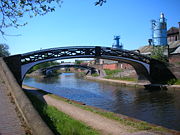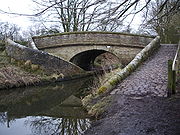
Roving bridge
Encyclopedia


Towpath
A towpath is a road or trail on the bank of a river, canal, or other inland waterway. The purpose of a towpath is to allow a land vehicle, beasts of burden, or a team of human pullers to tow a boat, often a barge...
changes sides. This often involved unhitching the tow line, but on some canals they were constructed so that there was no need to do this by placing the two ramps on the same side of the bridge, which turned the horse through 360 degrees. On the Macclesfield Canal
Macclesfield Canal
The Macclesfield Canal is a canal in east Cheshire, England, one of the six that make up the Cheshire Ring.-Route:The canal runs from Marple Junction at Marple, where it joins the Upper Peak Forest Canal, , southwards , before arriving at Bosley.Having descended the 12 Bosley Locks over the course...
this was achieved by building spiral ramps and on the Stratford-upon-Avon Canal
Stratford-upon-Avon Canal
The Stratford-upon-Avon Canal is a canal in the south Midlands of England.The canal, which was built between 1793 and 1816, runs for in total, and consists of two sections. The dividing line is at Kingswood Junction, which gives access to the Grand Union Canal...
by constructing roving bridges of iron in two cantilevered halves, leaving a slot in the middle for the tow rope. For cost reasons many ordinary Stratford bridges were also built in this way as they had no tow path.
Bridges were also necessary at canal junctions and where the towpath was interrupted by side arms. These are strictly speaking side bridges, but they are often referred to as roving bridges. Well-known ones occur at Hawkesbury Junction
Hawkesbury Junction
Hawkesbury Junction or Sutton Stop is a canal junction at the northern limit of the Oxford Canal where it meets the Coventry Canal, near Hawkesbury Village, Warwickshire, on the West Midlands county border, England...
and Haywood Junction
Haywood Junction
Haywood Junction , or Great Haywood Junction, is the name of the canal junction where the Staffordshire and Worcestershire Canal terminates and meets the Trent and Mersey Canal near to the village of Great Haywood, Staffordshire, England....
. The Birmingham Canal Navigations
Birmingham Canal Navigations
Birmingham Canal Navigations is a network of navigable canals connecting Birmingham, Wolverhampton, and the eastern part of the Black Country...
has many examples, mainly of cast iron, which took the towpaths across factory arms.
The ramps of the bridge are typically studded with alternating rows of protruding bricks to prevent the feet of the horse from sliding. The bridge may be constructed of cast iron (particularly in industrial areas) or of more conventional brick or stone.
See also
- Canals of the United KingdomCanals of the United KingdomThe canals of the United Kingdom are a major part of the network of inland waterways in the United Kingdom. They have a colourful history, from use for irrigation and transport, through becoming the focus of the Industrial Revolution, to today's role for recreational boating...
- History of the British canal systemHistory of the British canal systemThe British canal system of water transport played a vital role in the United Kingdom's Industrial Revolution at a time when roads were only just emerging from the medieval mud and long trains of pack horses were the only means of "mass" transit by road of raw materials and finished products The...

